I recently got the Aerosoft Catalina, and I thought I would write a "mini review" of it, not in the comprehensive style of Avsim, where we look at all the various features inside and out, but sort of as an informal transcription of my first impressions on a flight early on in the learning process. Some may find this boring, others may enjoy it, I hope. I thought that this encapsulated some of the thought process that goes on, and what it means when we "get a new toy."
***
Needless to say I spent a little while familiarizing myself with the essentials through the manual, and sitting in the cockpit. There were a number of preliminary set up steps particular to my machine and hardware setup that I have skipped for brevity, such as mapping mixture levers with a Lua script. I took a few screwing-around practice circuits, tweaking my EZCA custom viewpoints, mapped hardware, etc... But now we are going to do it for "real".
I have randomly picked the Midway Paint PBY-5. Today's flight will be from KPAE over the SEA VOR, to the OLM Vor, then to the HQM VOR (Hoquiam). There is a little airstrip there, just to the north of the HQM Vor designated as W04. Don't know what it is, frankly don't care, because I'm kind of in a rush tonight. No one would ever fly so randomly in real life, but this isn't real life, and I'm eager to get in the air! As such, I'll be okay with flying the default payload (a torpedo!), and to get my weight to 28000 lbs on takeoff, I've simply reduced the fuel in each tank to 70%.
As soon as the Sim starts, my engines die. I had neglected to tell FSUIPC to recognize this particular paint, and it let the engines in idle/cutoff since no controls were mapped. This is quickly resolved, but even though I hadn't been planning on doing a cold start, I guess I'm going to have to learn how to start the engines anyway, so it might as well be now. By checklist, I turn the magnetos off, and put the engines at idle cut off, and the throttles at 1/4 inch. Basically it is press the start button, count to 6 (12 prop revs), hit the primer for 4 seconds, turn the magnetos to both, and then move the mixture to full rich. I am happy to say I got Eng number 2 the first time. For engine number 1, it took me three tries to successfully start it.
But now we are up and running.
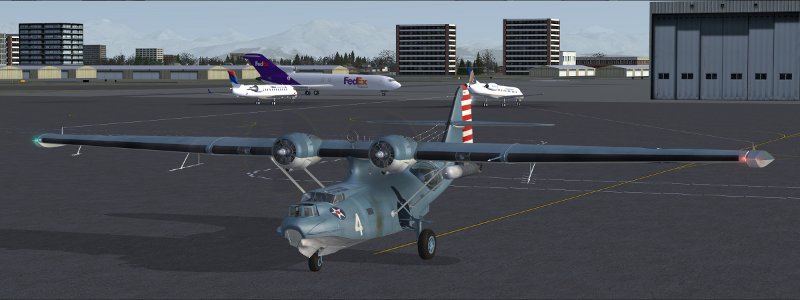
I take this moment while I am still parked to hit my EZCA hotkey and take me to the radio room. What they have back there, on the vintage version, is a simple radio stack with a period look. 2 Coms, 2 Navs, and ADF. Up front, the only thing you have (in this period model/paint) is a Radio pointer for NAV 1. All I have to do is tune my Nav1 back here in the Radio room, and then follow the pointer up front. I tune 116.80, SEA, my first leg.
Even though the wind is blowing 003 at 6, FSX ATC tells me to take off from rwy 16L. I give the engines a little juice and begin the taxi, and at the same time hit Shift-F2 to bring up the non-vocal, but definitely interactive pre-takeoff checklist. As I divide my attention between the checklist items, and steering down the taxi way, I notice how this plane seems to bounce gently along. Part of it is my EZCA settings, but there is more to it than that. They have definitely done something cool with the ground handling of this plane.
I line up. From the manual I know that I should give it full power, 48 inches and 2700rpm, cowl flaps cracked. I pour on the power gradually. The sound comes alive and it sounds GOOD! I have to make a lot of correction to counteract the torque, which is more than I expected. I've only given it a tad of trim, and I nudge it just a bit at 87 knots, which also happens to be Vyse. The craft lifts into the air much more gently than a lot of other aircraft, some of which seem to jump off the ground. In the ground effect, I hold the climb rate low to achieve 95 knots which is my best rate of climb, and then pitch up to hold it. I misjudge, since I'm very new to this plane, and I let the speed accelerate somewhat past my target. At 400 feet, I call for climb power (32.5 inches, 2325 RPM). There is a published figure for METO, but it doesn't really apply here. My speed control needs some work here, but this is the first time I've tried, so I'm not too hard on myself. Eventually, I trim the aircraft and am pleased to see it climbing at almost exactly 95 knots, unwavering, 500 fpm, at the documented climb power setting.
There isn't much of a turn going from KPAE 16L to the SEA vor, so I take the opportunity to snake around a bit as I climb. This plane feels "sloshy". As it enters the turn, you must apply just a tiny bit of rudder. The plane is easy to coordinate, except when you roll out of the turn, there seems to be a lot of momentum there and it slips a bit. I guess this is intentional, and it certainly makes it feel "lumbering". Everything in this plane feels somewhat slow and leisurely.
I settle into my climb which will be up to 6500 feet. The airplane is stable enough on trims, that I am not overworked as I do the after takeoff checks, set my cowl flaps, watch the temperatures, look around etcetera. This is not the A2A Stratocruiser where a 1 person takeoff and climb is a panic moment. Like I said, everything in this plane feels like a lazy stroll. The pace is slow. Some might like that...I'm not so sure yet. This plane is suppossed to be slow and ungainly right???
(Over SEA VOR)
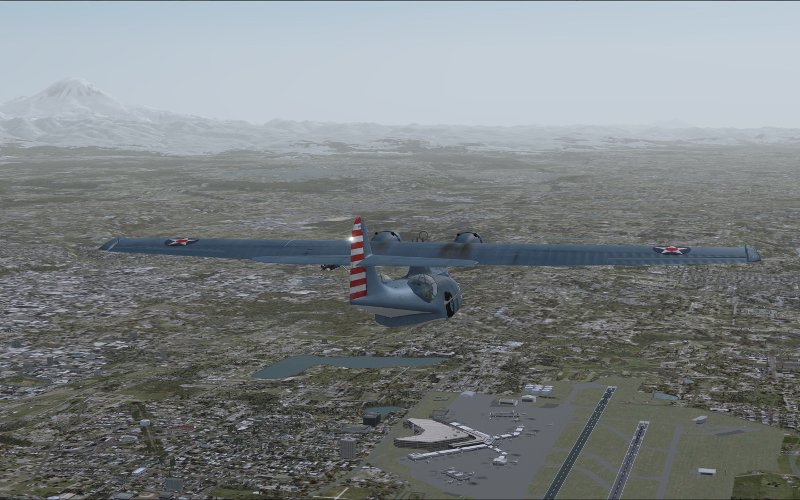
As I achieve 6500 feet, I level off, set Cruise power at 26 inches and 2050 RPM. The plane achieves 105 knots indicated...thats it. This is a good time to engage the Sperry Autopilot. I've never used it before, and don't know anything about it. I flip one of the levers I mapped on the CH throttle quad, and the Gyro engages. Now I must peer over the yoke at 3 tiny little Gain Switches. These are hard to get to, and I'm glad I have a TrackIR and EZCA. I randomly turn the gain up on Elevator, Aileron, and Rudder. I play around with it, and with a combination of using Trim, I get it to hold a course and altitude, sort of. I make a mental note to go back and read the manual about it for next time. For now, it is good enough. When the airplane drifts, I simply disengage the Gyro lever, put the plane back where it needs to be, and then re-engage. What the heck else am I going to be doing as I'm sitting here?
(The gyro control lever and mixtures located behind the pilot)
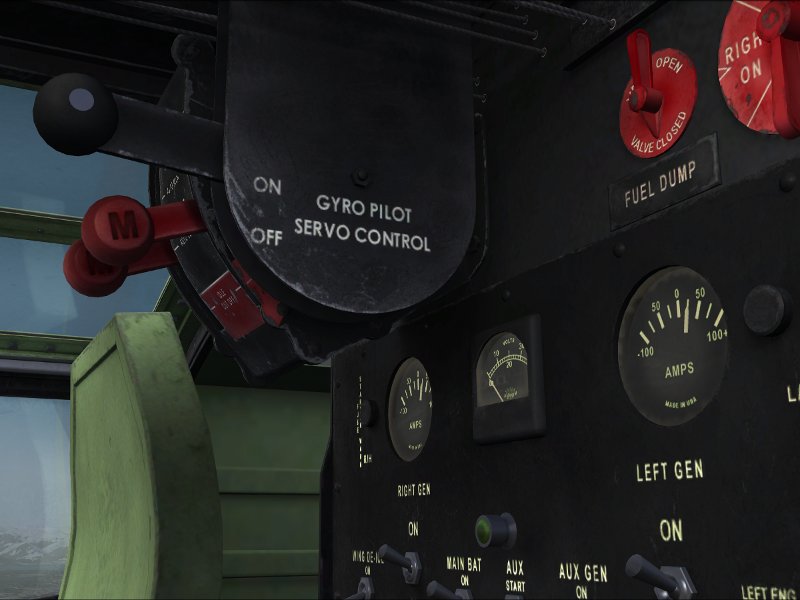
(The hard to reach, small Gryo gain knobs, circled in yellow)
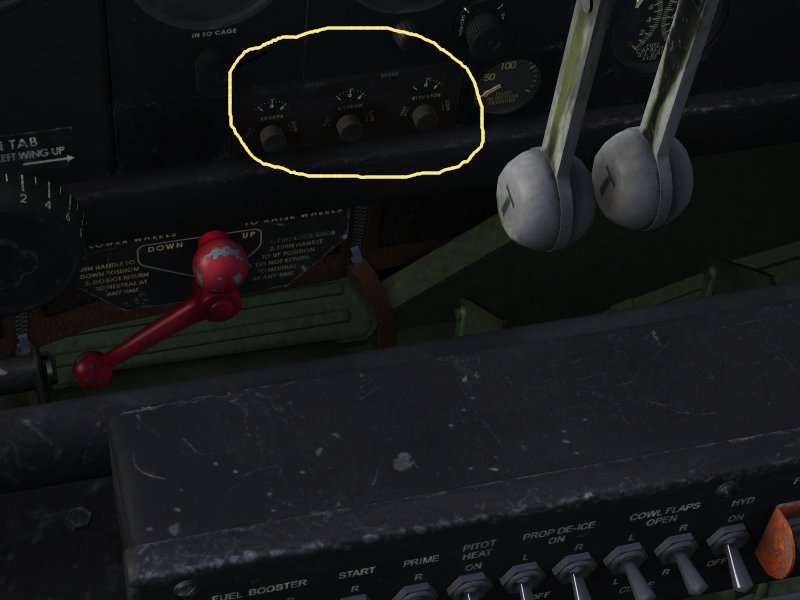
I didn't keep track of the time, like I should have if I were doing things properly. As I fly the plane from VOR to VOR I split my attention between taking screenshots, looking up numbers in the manual, reviewing my V speeds, going to the
refrigerator, etc...This plane is also quite visually pleasing.
(enjoying some of the views during cruise)
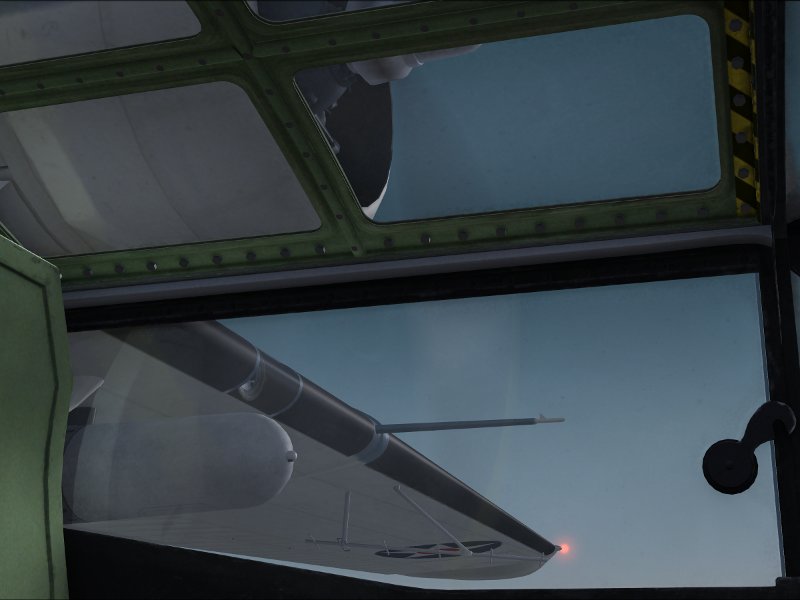
Since I didn't do any real flight planning, I begin my descent at a point based simply on best guess and the fact that the
weather is really clear and I can see the landscape that I'm flying into from way out. I target 500 feet per minute, like the book says. I gradually pull the power back an inch per minute until I'm at 20. Its easy to hold 500 fpm and whatever speed that gives me, which only happens to be 120 knots at the top of descent.
At HQM Vor I turn North and hunt visually for W04. Immediately I realize that in real life, you would NEVER land a plane like this there. It is 3500 feet long, but its nestled between trees, and perilously narrow. I enter a left hand pattern at 1000 feet, and reduce speed to 90 knots. Even though this is the first time doing any of this with this airplane, I find it is really really easy to achieve the proper "configuration". I put it in quotes because this plane doesn't have any Flaps to think about. Put it on 20 inches, drop the gear, and there you are where you need to be at, just like the documents said. So far, I'm extremely impressed by how this plane is flying on the numbers. For me, in Flight Sim, that might be one of the most important things. Anyway, I've completed the appropriate interactive checklist by this time as well, so I'm ready to land.
My pattern has been too small and I lose more altitude turning onto base then I wanted to, and then I'm a bit late turning to final, but this is something that will take practice. I make a mental note to fly a wider patter next time, and I know I'll get better at the more I fly this plane. I immediately see that this is going to be a stupid landing to do: I had wanted to see if I could fly this plane in on the published numbers, but unfortunately this is going to be more of a bush landing...I typically tend to fly Jets in the sim, and have almost no experience at "winging" it like this. (I wish I had taken more screenshots of this approach) Ideally, I should cross the threshold at 70 knots. I'm somewhat over 80 when I finally clear the trees and then have to let it drop in at twice the descent rate I would like to be at. I reduce my throttles below 20 inches and I see my RPM start to decay. This probably means I'm doing something bad to those big radial engines.
(final approach, steep, descent, dragging the props to get my speed down. Not the worlds greatest short final!)

A note about handling on the landing: I mentioned that the plane is "sloshy". I don't know if that is the right word, but at these speeds the only way I can describe it is sort of like the motion of a pendulum. That is what the ball is doing inside the turn coordinator, and part of it is my own doing as I try to sideslip it onto this horribly narrow runway. This is going to take some practice to get good at. My landing is better than I expected under the circumstance, but would have hoped for a smoother final approach. Not a good place to land when I'm so new to this airplane.
Thankfully, this is one of my better days of simulated piloting. I know that if I let it float, I'll drift right into the
grass, so I force the nose down a little bit and I land it quite firmly, but surprisingly at Vref, which is for all practical
purposes, is 70 knots. I suspect that this was more of a Jet landing than a PBY landing, but hey it worked. I forgot to move the prop levers forward on landing, but no big deal. I notice how long the nose stays in the air. At 40 knots, the nose is still hovering, if you can believe it. I finally push the yoke in and slam it down. I also note that the brakes are realistically weak. No quick stops here.
(landing at W04)
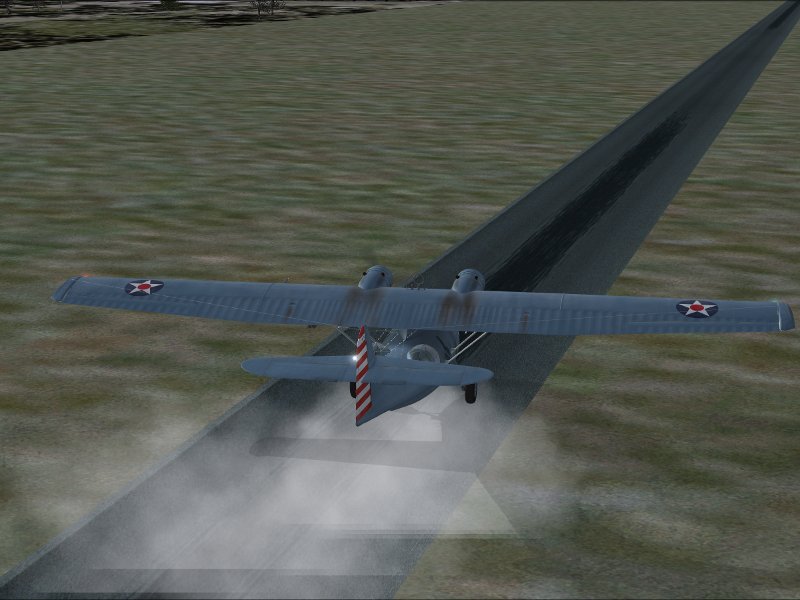
(My view over the nose at moment of landing)
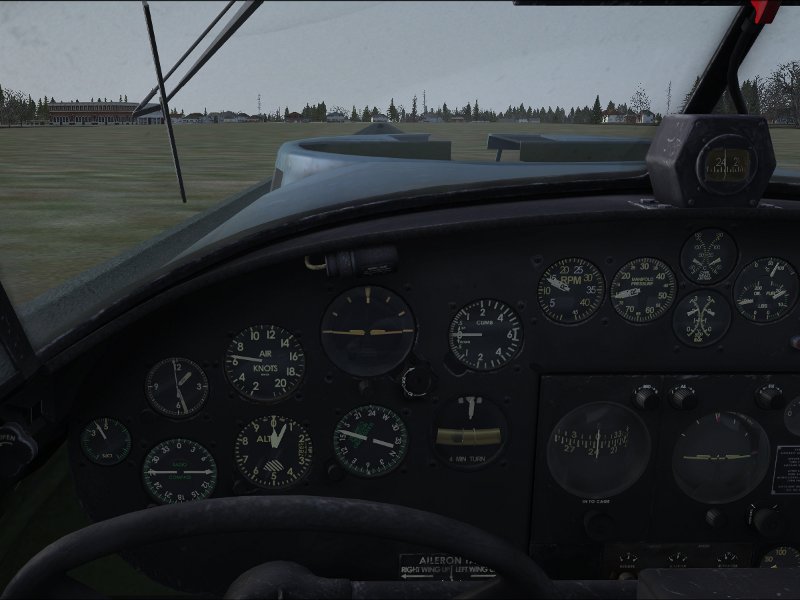
So what is the summary to all this? Clearly this is one of the better payware planes, on first glance it seems accurate as hell. It feels every bit the lumbering patrol plane that it is supposed to be. Overall very very easy to fly, but not without quirks. That is what I wanted. On the other hand, by its very nature...I'm searching for the right word...its not the world's most exciting airplane to fly. I've been spending the last couple of months getting good at the small jets and turboprops, which have a much different operational tempo. Give me a well done, accurate airplane, that in real life is somewhat unexciting, over a "hot" airplane whose realism is questionable any day!

